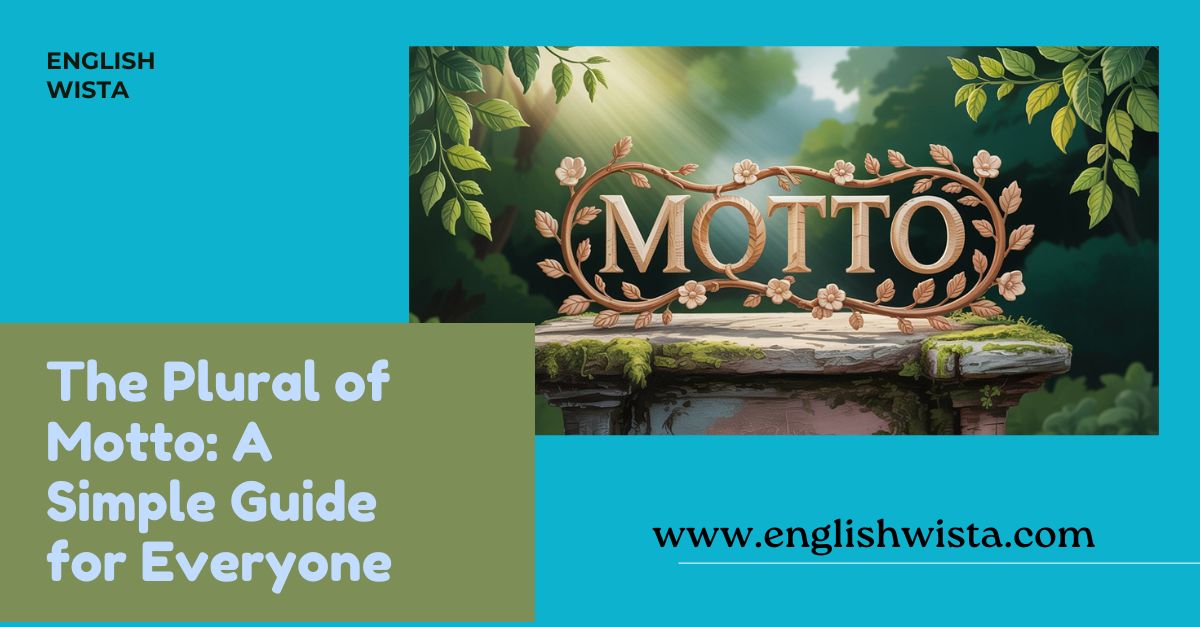Have you ever come across the word motto and wondered, “What’s the plural of this word?” If so, you’re not alone. Words that end in “-o” can be tricky in English because some of them add -es in the plural, while others just add -s. For example, the plural of tomato is tomatoes, but the plural of piano is pianos. So, where does motto fit in?
In this article, we’re going to clear up all the confusion in a friendly, step-by-step way. By the end, you’ll know exactly how to use motto in both its singular and plural forms, see it in real-life sentences, and even learn a few fun facts about its origin. Don’t worry we’ll keep it simple, conversational, and easy to follow.
Let’s dive in!
What Does “Motto” Mean?
Before we talk about plurals, let’s quickly understand what the word motto actually means.
A motto is a short phrase or sentence that expresses a guiding principle, belief, or idea. It’s like a slogan, but often more meaningful and personal.
Examples:
- “Honesty is the best policy” is a motto many people live by.
- Schools often have mottos that inspire students, like “Knowledge is power.”
- A sports team might adopt a motto such as “Play hard, play fair.”
So in short, a motto is a phrase that sums up an important belief or goal.
What Is the Plural of Motto?
Here’s the straightforward answer: the plural of motto is mottoes or mottos.
Yes, you read that right both are correct!
- Mottoes is the more traditional form and is often used in formal writing.
- Mottos is the simpler and more modern version, and you’ll see it commonly used in everyday English.
This means you can use either one, and people will understand you.
Why Are There Two Plural Forms?
English can be quirky, especially with words that end in “-o.” Some words follow the pattern of adding -es, while others just take -s.
- Words borrowed directly from Italian or Latin, like motto, originally used -es in the plural.
- Over time, English speakers began simplifying them, leading to the alternative -s form.
That’s why we have both mottoes and mottos today.
Which Form Should You Use?
This is a very common question, so let’s make it easy:
- If you’re writing something formal (like an academic essay, a book, or an official document), you might want to stick with mottoes.
- If you’re writing something informal (like a blog post, a conversation, or social media), mottos is perfectly fine.
Both are correct, so it really depends on your style and audience.
Is Motto Singular or Plural?
Motto by itself is singular. When you want to talk about more than one motto, you use mottoes or mottos.
Example:
- Singular: “Her life motto is ‘Never give up.’”
- Plural: “The organization has several mottos that inspire its members.”
Real-Life Examples of Motto in Sentences
Let’s look at how motto and its plurals are used in everyday sentences. Seeing words in action makes them easier to remember.
Singular Examples
- The company’s motto is “Customer first.”
- “Work hard, dream big” is his personal motto.
- The motto on the family crest reads, “Strength and honor.”
Plural Examples (Mottoes or Mottos)
- Schools around the world have different mottos that reflect their values.
- The army has adopted several mottoes over the years.
- Sports teams often create mottos to boost team spirit.
As you can see, both forms look natural in sentences.
Comparing Motto with Other “-o” Words
Since motto ends in “-o,” it’s easy to mix it up with similar words. Let’s compare it with a few others.
- Tomato → Tomatoes
- Potato → Potatoes
- Hero → Heroes
- Motto → Mottoes or Mottos
- Piano → Pianos
- Photo → Photos
Notice how some take -es while others just take -s. There’s no single rule that works for all, which is why memorization and practice are important.
Origin of the Word Motto
The word motto comes from Italian, which in turn comes from the Latin word muttire, meaning “to mutter” or “to say.” Over time, it developed into motto in Italian, meaning a word, phrase, or saying. English borrowed it in the 16th century, and since then, it has kept both its singular and plural forms.
This Italian origin explains why mottoes became the traditional plural form in English. But language changes, and people started using mottos because it felt simpler and more natural.
Fun Facts About Mottos
Let’s make this a little more interesting with some fun tidbits:
- National Mottos: Many countries have official mottos. For example, the United States motto is “In God We Trust.”
- Famous Brands: Companies often use mottos or slogans to define their identity. Think of Nike’s “Just Do It.” While technically a slogan, it works like a motto.
- Personal Use: People sometimes adopt mottos for their daily life, like “Stay positive” or “One step at a time.”
- Schools and Universities: Almost every major school has a motto that reflects its values, often written in Latin. For example, Harvard University’s motto is “Veritas,” meaning “Truth.”
Common Mistakes to Avoid
Because the word motto can be confusing, here are a few mistakes learners often make:
- ❌ Writing mottoes when you mean just one motto.
- ❌ Using only one plural form and thinking the other is wrong.
- ❌ Mixing it up with similar-sounding words like motor or mojo.
Remember: both mottoes and mottos are correct. The singular is always motto.
Quick Definitions Recap
- Motto (singular): A short phrase that expresses an idea or belief.
- Mottoes/Mottos (plural): More than one motto. Both spellings are correct.
Why Learning Plurals Matters
You might wonder, “Why is it even important to know the plural of motto?” The answer is simple: using the right form helps you sound more natural and confident in English. Whether you’re writing an essay, posting on social media, or just chatting with friends, small details like this make a big difference.
Tips to Remember the Plural of Motto
Here are some easy tricks:
- Think of mottoes as the “traditional” form and mottos as the “modern” one.
- When in doubt, use mottos it’s widely accepted today.
- Practice with sentences:
- “Our team has three mottos that we follow.”
- “The school motto inspires every student.”
Repetition helps the word stick in your memory.
A Few More Examples for Practice
Let’s try some additional sentences to strengthen your understanding:
- “Their family mottos are all about kindness and respect.”
- “Every brand has its own motto to attract customers.”
- “My motto is simple: work hard and stay humble.”
- “The football team came up with new mottoes for the season.”
Conclusion
So, what’s the takeaway here? The word motto can be a little confusing, but now you know the secret: the plural can be mottoes or mottos, and both are correct.
We also learned what a motto means, where the word comes from, and how to use it in sentences. Plus, we looked at fun examples from schools, teams, and even countries.
Next time someone asks you, “What’s the plural of motto?” you’ll have the answer ready and you can even impress them with the fact that there are two correct forms.
In short:
- Singular: motto
- Plural: mottoes or mottos
And remember, a motto isn’t just a word. It’s an idea, a principle, or a phrase that guides people in life. Maybe you even have your own motto without realizing it.
So, what’s your motto?



